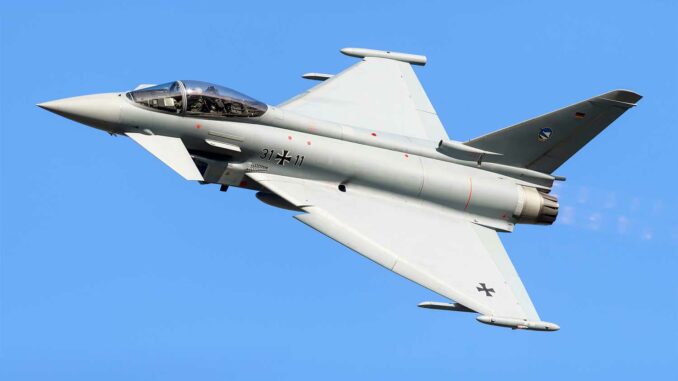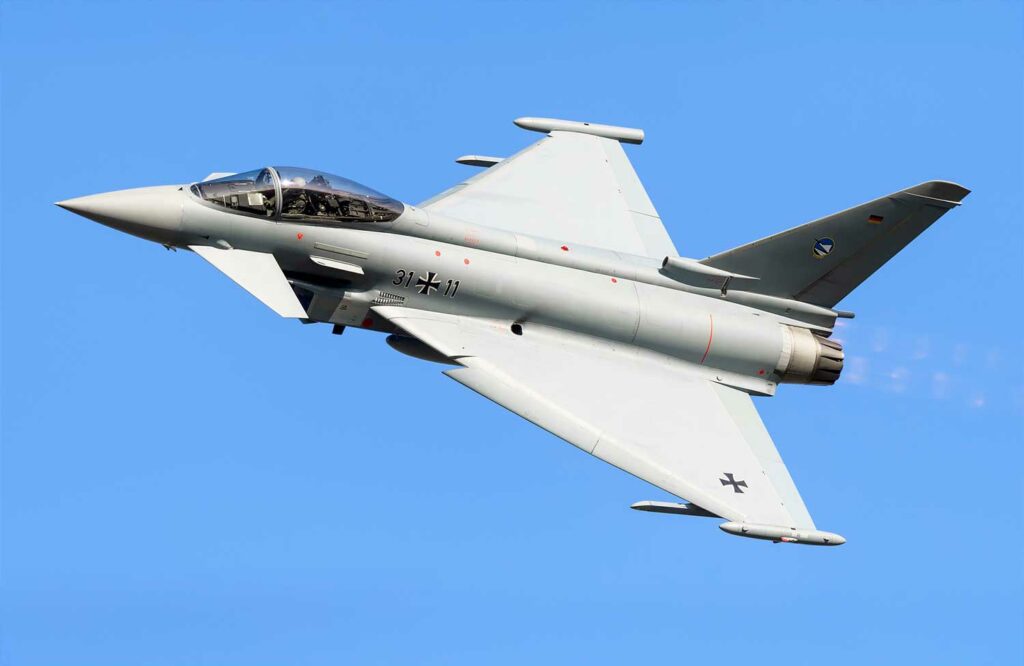
The Bundestag approves 20 Eurofighter Typhoons “Tranche 5” for €3.75 billion, with deliveries between 2031 and 2034 and a focus on electronic warfare, training, and NATO interoperability.
Summary
Germany has taken a new step forward in terms of capability with the approval of the Bundestag’s budget committee for the purchase of 20 standard Eurofighter Typhoon “Tranche 5” aircraft, worth €3.75 billion. The aircraft will be delivered between 2031 and 2034 and will contribute to the modernization of the Luftwaffe in air superiority, ground attack, reconnaissance, and electronic warfare missions. The deal includes engines and spare parts and is part of a series of decisions covering several major programs, including simulators and a package of improvements in air defense. The choice of the Typhoon is in line with German industrial and operational logic: maintaining the Airbus production line in Manching, standardizing logistics with the existing fleet, and preparing for the future FCAS. A purchase of Rafales would have fragmented support lines and blurred industrial priorities, given that Germany has already selected the F-35A for NATO’s nuclear mission. The impact for the Alliance is direct: increased deterrence capabilities and NATO interoperability in the medium term.
Budget approval and key figures
The Haushaltsausschuss decision
The budget committee approved the order for 20 Eurofighters for €3.75 billion. The order is one of several arms procurement decisions approved on the same day, representing more than €7 billion. The package includes airframes, a complete set of engines (52 units mentioned in the preparatory documents, i.e., two per aircraft plus reserves), interchangeable parts and components, and initial support lines. Deliveries are planned for 2031-2034 in order to smooth the budgetary effort and preserve industrial capabilities.
Production milestones
The schedule reflects the saturation of assembly slots and the desire to support the Eurofighter ecosystem in Germany. This order extends the momentum of the Quadriga program (38 aircraft ordered in 2020) and maintains production, testing, and systems integration expertise in Manching. The goal is to maintain a sovereign industrial base until the next-generation air combat system enters service.
Operational objective and “Tranche 5” capabilities
Sensor-effect standard
The Tranche 5 standard aims to increase sensor, connectivity, and survivability capabilities. The aircraft are equipped with an ECRS Mk1 active electronically scanned array (AESA) radar for Germany, improving multi-target detection, jamming resistance, and high-resolution mapping. This sensor supports air-to-air and air-to-ground functions, with better data fusion and more efficient use of precision-guided weapons.
The “Elektronischer Kampf” brick
Berlin is also financing a suite of equipment and software dedicated to electronic attack and suppression/destruction of air defenses (SEAD/DEAD). The transformation path to the Eurofighter EK configuration allows for the carriage of warning sensors, attack pods, and specialized munitions, gradually replacing the Tornado ECR. This trajectory anchors the Typhoon as a high-intensity, multi-role platform with endurance and payload suitable for extended campaigns.
Integration into the Luftwaffe and deployment schedule
The fleet and ramp-up
The Luftwaffe currently operates around 138 Eurofighters. With this tranche, the German Air Force is securing its critical mass for 2031–2034, while supporting the renovation of existing tranches (radars, electronic warfare, simulators). An additional investment of around €412 million is planned to modernize simulators and optimize training, a key factor in generating flight hours and operational readiness.
Targeted missions
The new aircraft will strengthen France’s air policing posture, permanent alert capability, and contribution to NATO operations on the eastern flank. They will also take on fire support, electromagnetic reconnaissance, and force coverage roles. The objective is to maintain “windows” of local superiority despite a denser ground-to-air threat, by coordinating fighter aircraft, tankers, and electronic warfare.

The industrial choice and the Rafale question
The consistency of the German portfolio
Germany is a framework nation in the Eurofighter Typhoon program alongside the United Kingdom, Italy, and Spain. Continuing with the Typhoon guarantees control of the supply chain, preserves jobs and know-how, and ensures sovereignty over data and maintenance. The massive introduction of a new type such as the Rafale would have required a second support infrastructure, specific training, and redundant stocks, for marginal operational added value given the planned developments of the Typhoon.
The role of the F-35A and the articulation of capabilities
Berlin has selected the F-35A for NATO’s nuclear sharing mission. This choice fills a critical niche that the Typhoon does not currently cover. Keeping the Typhoon for the conventional “high end of the spectrum” and entrusting the nuclear mission to the F-35A avoids dispersion. Purchasing the Rafale would have created a trio of heavy fighters to support (Typhoon, Rafale, F-35), without any industrial synergy in Germany. The Typhoon decision therefore appears rational, both financially and operationally.
The impact on NATO and Europe
Consolidating collective efforts
The arrival of a new tranche strengthens the Alliance’s overall availability in the 4.5 generation segment. NATO benefits from aircraft equipped with the latest generation of sensors, interoperable via secure data links, and capable of integrating electronic attack payloads. At the European level, the order supports a multinational program that provides thousands of skilled jobs and stabilizes the defense industrial base.
The response to long-term threats
Germany plans to extend the service life of the Typhoon fleet until 2060. By increasing the number of modern airframes and financing SEAD/DEAD capabilities, Berlin is helping to fill a recurring European gap: penetration in contested environments. The expected knock-on effect also extends to the standardization of armaments, predictive maintenance, and joint training.
Budgetary and scheduling implications
Financial phasing and cost inflation
The “contract” cost is equivalent to approximately €187 million per aircraft if the budget is divided among the 20 aircraft, but this figure includes engines, parts, documentation, and initial services. It therefore does not reflect a strict “flyaway cost.” The 2031-2034 phasing allows the impact to be smoothed out and takes into account input inflation, while ancillary investments (simulators, infrastructure, testing facilities) bring the overall bill beyond the “aircraft” line alone.
Industrial effects in Germany
The order secures years of work for the Airbus Defence and Space line and its subcontractors (airframes, sensor integration, testing), as well as for the maintenance network. It also consolidates radar and electronic warfare developments among national and European players, guaranteeing dual technological benefits.
The capability trajectory towards FCAS
The gateway to the next generation
The German General Staff presents this tranche as a bridge to FCAS, scheduled for 2040. The modernized Typhoon will ensure capability continuity in the 2030s, while FCAS building blocks (sensors, drone swarms, combat cloud) mature. Maintaining a homogeneous Typhoon fleet, modernized and compatible with collaborative combat concepts, facilitates the gradual integration of these building blocks.
Technical priorities to watch
Three points will be decisive: the completion of the ECRS Mk1 milestones and their retrofitting on existing fleets; the ramp-up of the Eurofighter EK standard with its self-protection and attack suites; and the integration of new air-to-ground and stand-off weapons. The success of these projects will determine Germany’s ability to operate in depth against multi-layered defenses.
The strategic significance of a targeted order
A sign of military credibility
This decision clarifies the Luftwaffe‘s roadmap. It guarantees a credible combat base, improves industrial resilience, and aligns Berlin with NATO’s needs for the 2030s. The choice of technical and industrial continuity is pragmatic: it minimizes risks, accelerates ramp-up, and focuses efforts on key capabilities.
A testing and doctrine agenda
The investment now needs to be translated into doctrine and training. Modernized simulators and sensor-effect testing campaigns will have to precede the first deliveries. Conducting exercises that integrate electronic warfare, refueling, and dynamic targeting will help validate uses and procedures. This is the price that must be paid for the Eurofighter Typhoon “Tranche 5” to deliver its full potential.
War Wings Daily is an independant magazine.